Commercial and Corporation Law: Analysis of Share and Dividend Laws
VerifiedAdded on 2020/02/24
|8
|1864
|112
Report
AI Summary
This report analyzes key aspects of commercial and corporation law in Australia, focusing on dividends, share buy-backs, and capital reduction. It begins by defining dividends and their relation to shares, referencing the Corporations Act 2001 and relevant case law such as Re Centro Properties Ltd and Taylor v Babcock & Brown Ltd. The report then examines share buy-backs, explaining their benefits and requirements, including open market and off-market processes. Finally, it delves into capital reduction, outlining the process, requirements, and the necessary consents, as per the Corporations Act 2001, including the role of the Australian Securities and Investment Commission (ASIC). The report provides a comprehensive overview of these critical corporate finance concepts, supported by legal provisions and relevant case examples.
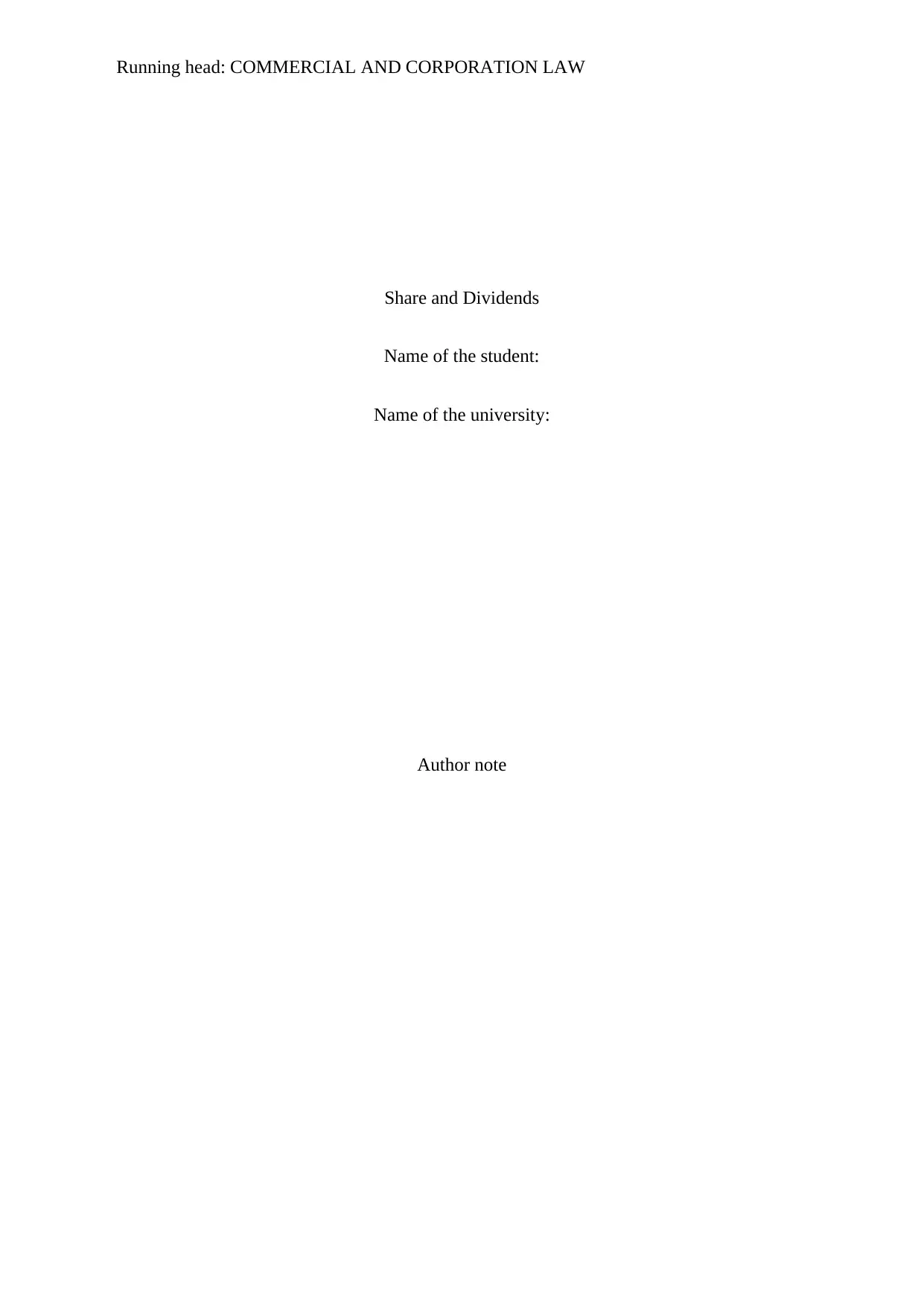
Running head: COMMERCIAL AND CORPORATION LAW
Share and Dividends
Name of the student:
Name of the university:
Author note
Share and Dividends
Name of the student:
Name of the university:
Author note
Paraphrase This Document
Need a fresh take? Get an instant paraphrase of this document with our AI Paraphraser
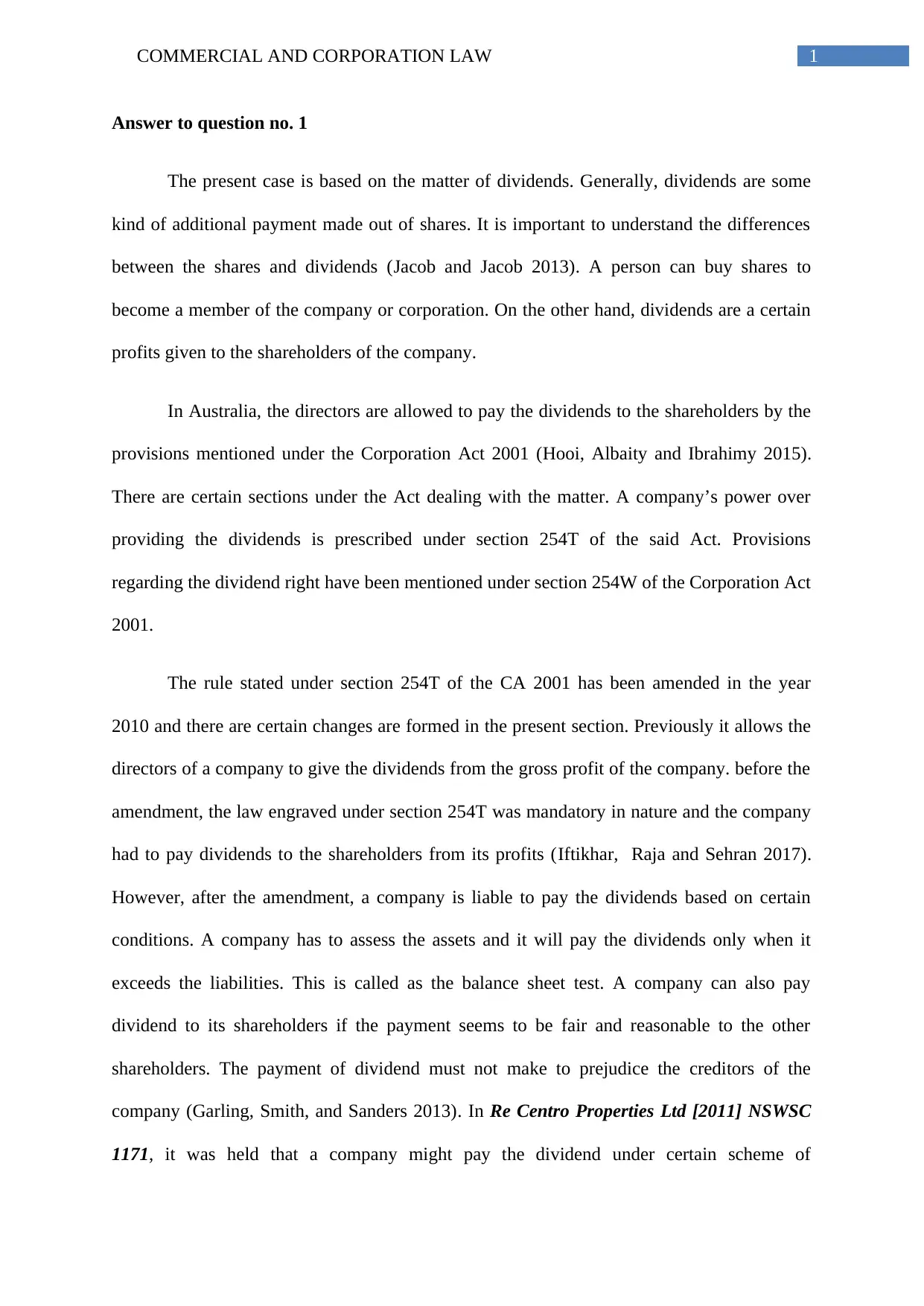
1COMMERCIAL AND CORPORATION LAW
Answer to question no. 1
The present case is based on the matter of dividends. Generally, dividends are some
kind of additional payment made out of shares. It is important to understand the differences
between the shares and dividends (Jacob and Jacob 2013). A person can buy shares to
become a member of the company or corporation. On the other hand, dividends are a certain
profits given to the shareholders of the company.
In Australia, the directors are allowed to pay the dividends to the shareholders by the
provisions mentioned under the Corporation Act 2001 (Hooi, Albaity and Ibrahimy 2015).
There are certain sections under the Act dealing with the matter. A company’s power over
providing the dividends is prescribed under section 254T of the said Act. Provisions
regarding the dividend right have been mentioned under section 254W of the Corporation Act
2001.
The rule stated under section 254T of the CA 2001 has been amended in the year
2010 and there are certain changes are formed in the present section. Previously it allows the
directors of a company to give the dividends from the gross profit of the company. before the
amendment, the law engraved under section 254T was mandatory in nature and the company
had to pay dividends to the shareholders from its profits (Iftikhar, Raja and Sehran 2017).
However, after the amendment, a company is liable to pay the dividends based on certain
conditions. A company has to assess the assets and it will pay the dividends only when it
exceeds the liabilities. This is called as the balance sheet test. A company can also pay
dividend to its shareholders if the payment seems to be fair and reasonable to the other
shareholders. The payment of dividend must not make to prejudice the creditors of the
company (Garling, Smith, and Sanders 2013). In Re Centro Properties Ltd [2011] NSWSC
1171, it was held that a company might pay the dividend under certain scheme of
Answer to question no. 1
The present case is based on the matter of dividends. Generally, dividends are some
kind of additional payment made out of shares. It is important to understand the differences
between the shares and dividends (Jacob and Jacob 2013). A person can buy shares to
become a member of the company or corporation. On the other hand, dividends are a certain
profits given to the shareholders of the company.
In Australia, the directors are allowed to pay the dividends to the shareholders by the
provisions mentioned under the Corporation Act 2001 (Hooi, Albaity and Ibrahimy 2015).
There are certain sections under the Act dealing with the matter. A company’s power over
providing the dividends is prescribed under section 254T of the said Act. Provisions
regarding the dividend right have been mentioned under section 254W of the Corporation Act
2001.
The rule stated under section 254T of the CA 2001 has been amended in the year
2010 and there are certain changes are formed in the present section. Previously it allows the
directors of a company to give the dividends from the gross profit of the company. before the
amendment, the law engraved under section 254T was mandatory in nature and the company
had to pay dividends to the shareholders from its profits (Iftikhar, Raja and Sehran 2017).
However, after the amendment, a company is liable to pay the dividends based on certain
conditions. A company has to assess the assets and it will pay the dividends only when it
exceeds the liabilities. This is called as the balance sheet test. A company can also pay
dividend to its shareholders if the payment seems to be fair and reasonable to the other
shareholders. The payment of dividend must not make to prejudice the creditors of the
company (Garling, Smith, and Sanders 2013). In Re Centro Properties Ltd [2011] NSWSC
1171, it was held that a company might pay the dividend under certain scheme of
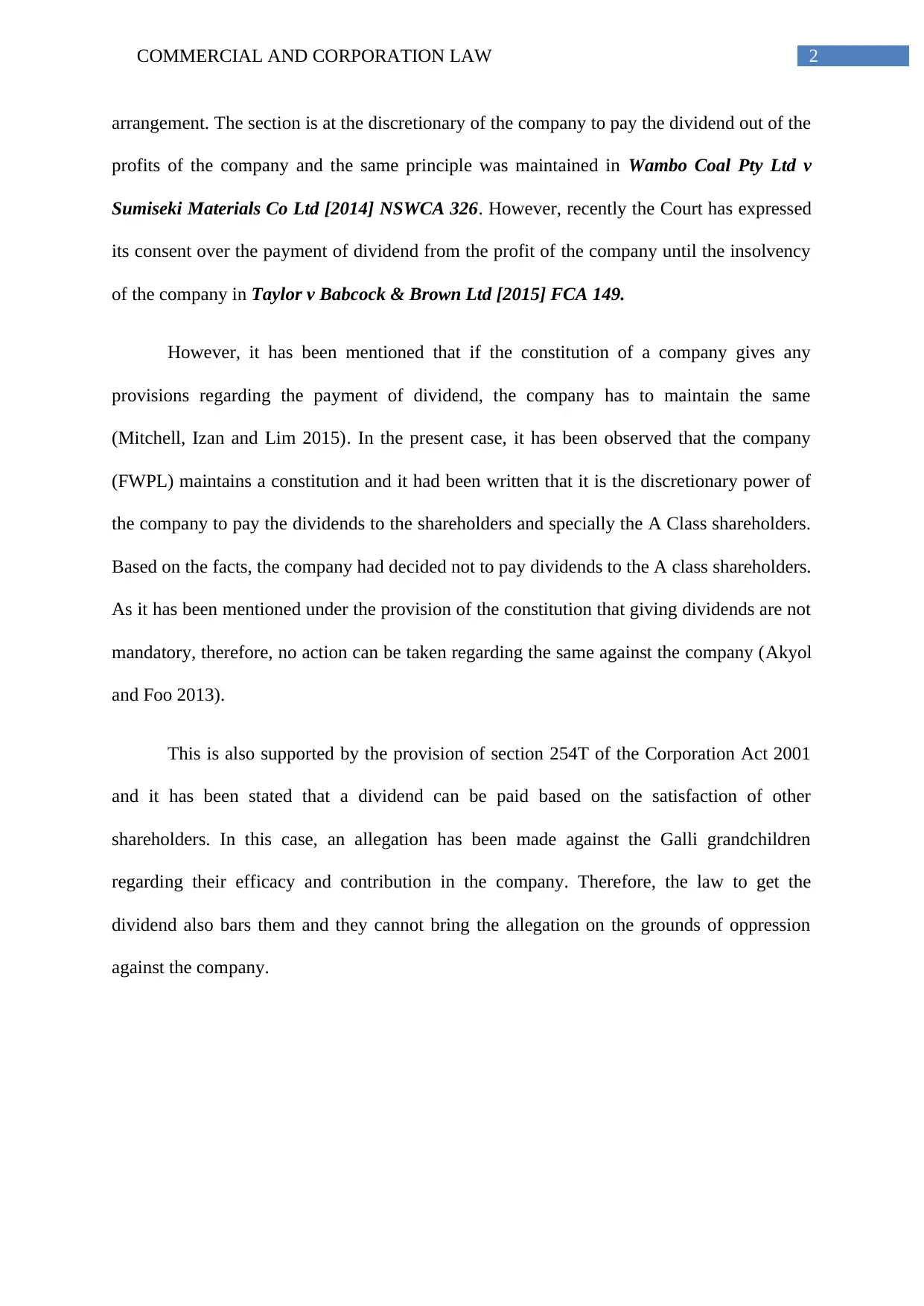
2COMMERCIAL AND CORPORATION LAW
arrangement. The section is at the discretionary of the company to pay the dividend out of the
profits of the company and the same principle was maintained in Wambo Coal Pty Ltd v
Sumiseki Materials Co Ltd [2014] NSWCA 326. However, recently the Court has expressed
its consent over the payment of dividend from the profit of the company until the insolvency
of the company in Taylor v Babcock & Brown Ltd [2015] FCA 149.
However, it has been mentioned that if the constitution of a company gives any
provisions regarding the payment of dividend, the company has to maintain the same
(Mitchell, Izan and Lim 2015). In the present case, it has been observed that the company
(FWPL) maintains a constitution and it had been written that it is the discretionary power of
the company to pay the dividends to the shareholders and specially the A Class shareholders.
Based on the facts, the company had decided not to pay dividends to the A class shareholders.
As it has been mentioned under the provision of the constitution that giving dividends are not
mandatory, therefore, no action can be taken regarding the same against the company (Akyol
and Foo 2013).
This is also supported by the provision of section 254T of the Corporation Act 2001
and it has been stated that a dividend can be paid based on the satisfaction of other
shareholders. In this case, an allegation has been made against the Galli grandchildren
regarding their efficacy and contribution in the company. Therefore, the law to get the
dividend also bars them and they cannot bring the allegation on the grounds of oppression
against the company.
arrangement. The section is at the discretionary of the company to pay the dividend out of the
profits of the company and the same principle was maintained in Wambo Coal Pty Ltd v
Sumiseki Materials Co Ltd [2014] NSWCA 326. However, recently the Court has expressed
its consent over the payment of dividend from the profit of the company until the insolvency
of the company in Taylor v Babcock & Brown Ltd [2015] FCA 149.
However, it has been mentioned that if the constitution of a company gives any
provisions regarding the payment of dividend, the company has to maintain the same
(Mitchell, Izan and Lim 2015). In the present case, it has been observed that the company
(FWPL) maintains a constitution and it had been written that it is the discretionary power of
the company to pay the dividends to the shareholders and specially the A Class shareholders.
Based on the facts, the company had decided not to pay dividends to the A class shareholders.
As it has been mentioned under the provision of the constitution that giving dividends are not
mandatory, therefore, no action can be taken regarding the same against the company (Akyol
and Foo 2013).
This is also supported by the provision of section 254T of the Corporation Act 2001
and it has been stated that a dividend can be paid based on the satisfaction of other
shareholders. In this case, an allegation has been made against the Galli grandchildren
regarding their efficacy and contribution in the company. Therefore, the law to get the
dividend also bars them and they cannot bring the allegation on the grounds of oppression
against the company.
⊘ This is a preview!⊘
Do you want full access?
Subscribe today to unlock all pages.

Trusted by 1+ million students worldwide
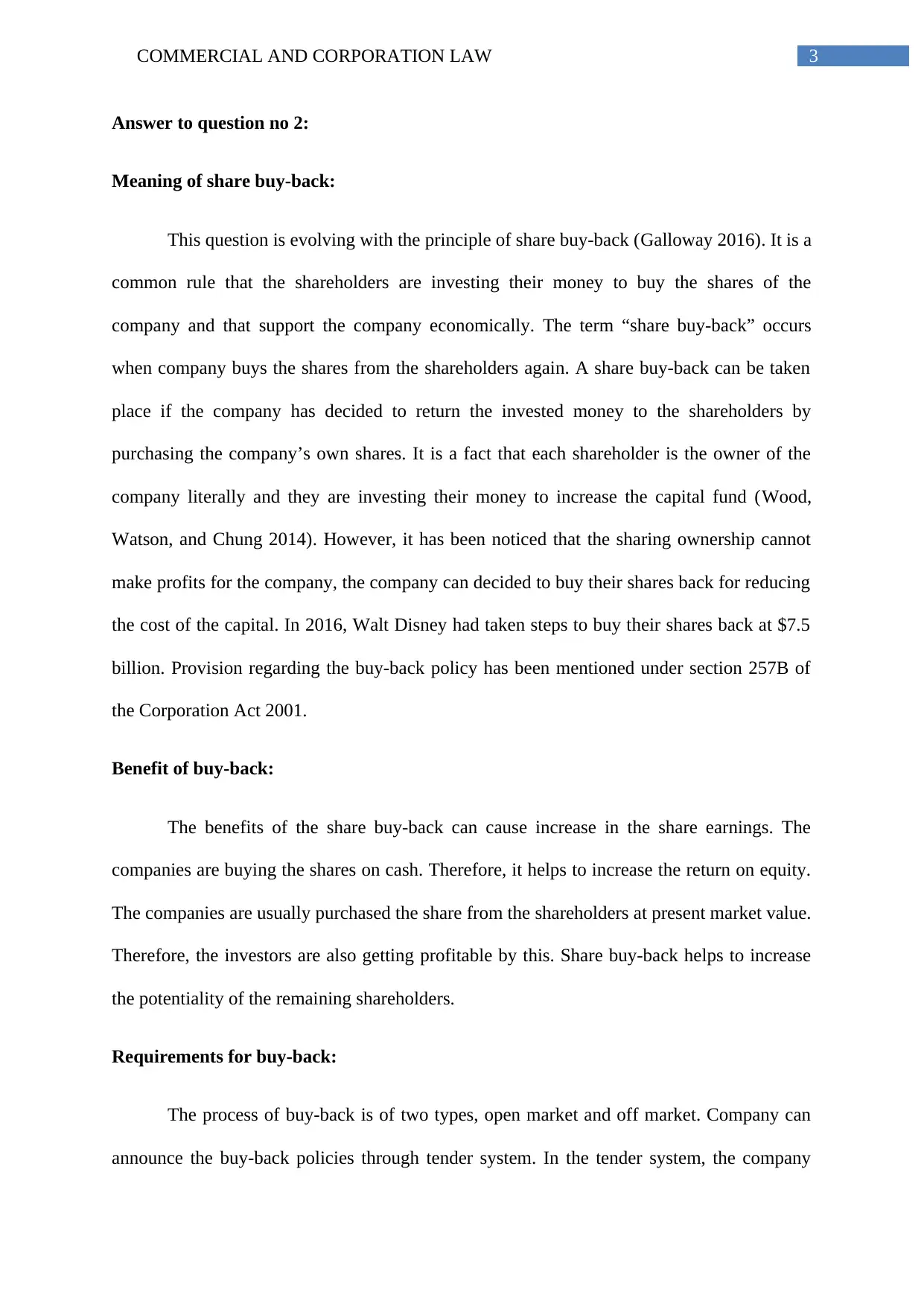
3COMMERCIAL AND CORPORATION LAW
Answer to question no 2:
Meaning of share buy-back:
This question is evolving with the principle of share buy-back (Galloway 2016). It is a
common rule that the shareholders are investing their money to buy the shares of the
company and that support the company economically. The term “share buy-back” occurs
when company buys the shares from the shareholders again. A share buy-back can be taken
place if the company has decided to return the invested money to the shareholders by
purchasing the company’s own shares. It is a fact that each shareholder is the owner of the
company literally and they are investing their money to increase the capital fund (Wood,
Watson, and Chung 2014). However, it has been noticed that the sharing ownership cannot
make profits for the company, the company can decided to buy their shares back for reducing
the cost of the capital. In 2016, Walt Disney had taken steps to buy their shares back at $7.5
billion. Provision regarding the buy-back policy has been mentioned under section 257B of
the Corporation Act 2001.
Benefit of buy-back:
The benefits of the share buy-back can cause increase in the share earnings. The
companies are buying the shares on cash. Therefore, it helps to increase the return on equity.
The companies are usually purchased the share from the shareholders at present market value.
Therefore, the investors are also getting profitable by this. Share buy-back helps to increase
the potentiality of the remaining shareholders.
Requirements for buy-back:
The process of buy-back is of two types, open market and off market. Company can
announce the buy-back policies through tender system. In the tender system, the company
Answer to question no 2:
Meaning of share buy-back:
This question is evolving with the principle of share buy-back (Galloway 2016). It is a
common rule that the shareholders are investing their money to buy the shares of the
company and that support the company economically. The term “share buy-back” occurs
when company buys the shares from the shareholders again. A share buy-back can be taken
place if the company has decided to return the invested money to the shareholders by
purchasing the company’s own shares. It is a fact that each shareholder is the owner of the
company literally and they are investing their money to increase the capital fund (Wood,
Watson, and Chung 2014). However, it has been noticed that the sharing ownership cannot
make profits for the company, the company can decided to buy their shares back for reducing
the cost of the capital. In 2016, Walt Disney had taken steps to buy their shares back at $7.5
billion. Provision regarding the buy-back policy has been mentioned under section 257B of
the Corporation Act 2001.
Benefit of buy-back:
The benefits of the share buy-back can cause increase in the share earnings. The
companies are buying the shares on cash. Therefore, it helps to increase the return on equity.
The companies are usually purchased the share from the shareholders at present market value.
Therefore, the investors are also getting profitable by this. Share buy-back helps to increase
the potentiality of the remaining shareholders.
Requirements for buy-back:
The process of buy-back is of two types, open market and off market. Company can
announce the buy-back policies through tender system. In the tender system, the company
Paraphrase This Document
Need a fresh take? Get an instant paraphrase of this document with our AI Paraphraser
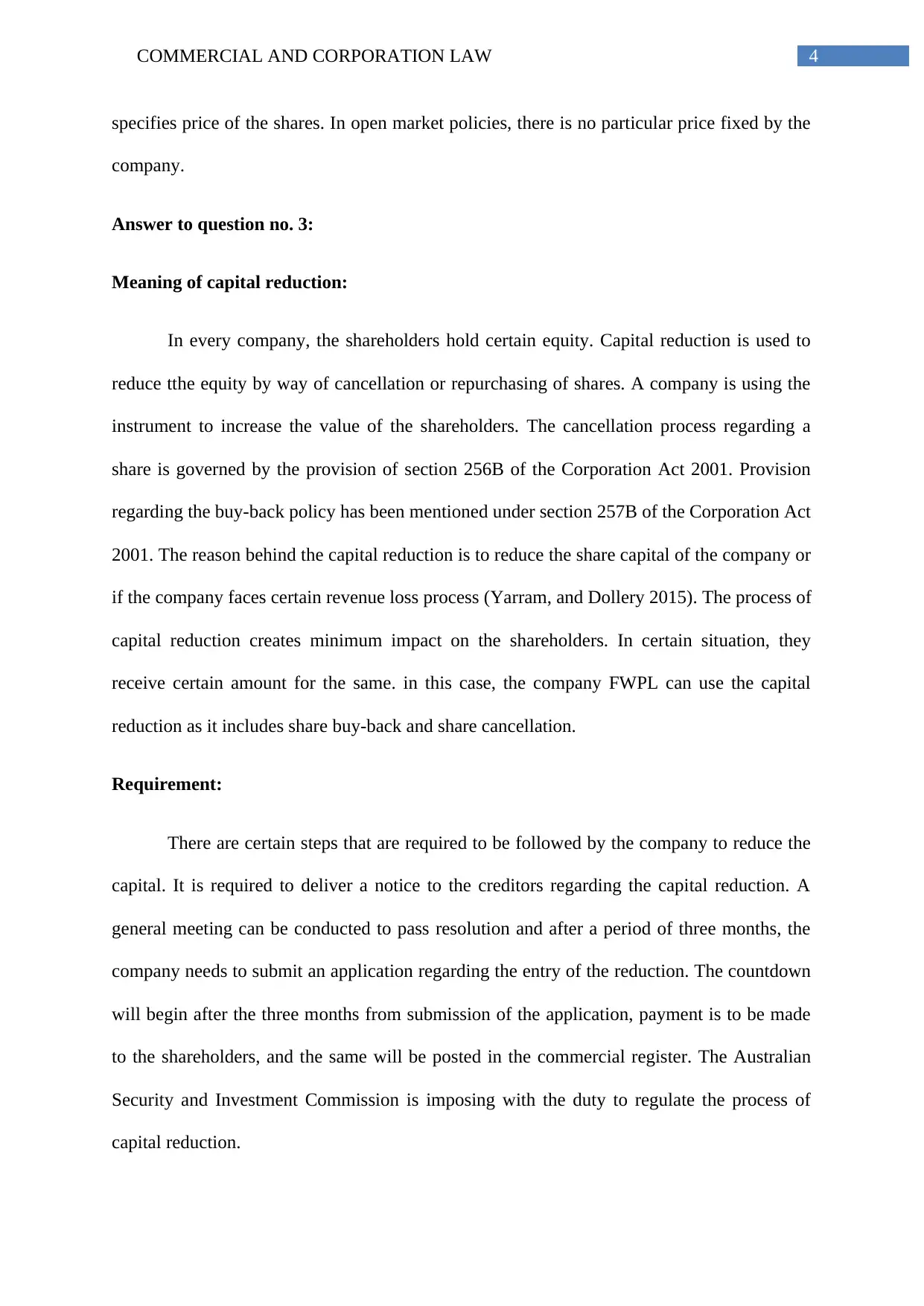
4COMMERCIAL AND CORPORATION LAW
specifies price of the shares. In open market policies, there is no particular price fixed by the
company.
Answer to question no. 3:
Meaning of capital reduction:
In every company, the shareholders hold certain equity. Capital reduction is used to
reduce tthe equity by way of cancellation or repurchasing of shares. A company is using the
instrument to increase the value of the shareholders. The cancellation process regarding a
share is governed by the provision of section 256B of the Corporation Act 2001. Provision
regarding the buy-back policy has been mentioned under section 257B of the Corporation Act
2001. The reason behind the capital reduction is to reduce the share capital of the company or
if the company faces certain revenue loss process (Yarram, and Dollery 2015). The process of
capital reduction creates minimum impact on the shareholders. In certain situation, they
receive certain amount for the same. in this case, the company FWPL can use the capital
reduction as it includes share buy-back and share cancellation.
Requirement:
There are certain steps that are required to be followed by the company to reduce the
capital. It is required to deliver a notice to the creditors regarding the capital reduction. A
general meeting can be conducted to pass resolution and after a period of three months, the
company needs to submit an application regarding the entry of the reduction. The countdown
will begin after the three months from submission of the application, payment is to be made
to the shareholders, and the same will be posted in the commercial register. The Australian
Security and Investment Commission is imposing with the duty to regulate the process of
capital reduction.
specifies price of the shares. In open market policies, there is no particular price fixed by the
company.
Answer to question no. 3:
Meaning of capital reduction:
In every company, the shareholders hold certain equity. Capital reduction is used to
reduce tthe equity by way of cancellation or repurchasing of shares. A company is using the
instrument to increase the value of the shareholders. The cancellation process regarding a
share is governed by the provision of section 256B of the Corporation Act 2001. Provision
regarding the buy-back policy has been mentioned under section 257B of the Corporation Act
2001. The reason behind the capital reduction is to reduce the share capital of the company or
if the company faces certain revenue loss process (Yarram, and Dollery 2015). The process of
capital reduction creates minimum impact on the shareholders. In certain situation, they
receive certain amount for the same. in this case, the company FWPL can use the capital
reduction as it includes share buy-back and share cancellation.
Requirement:
There are certain steps that are required to be followed by the company to reduce the
capital. It is required to deliver a notice to the creditors regarding the capital reduction. A
general meeting can be conducted to pass resolution and after a period of three months, the
company needs to submit an application regarding the entry of the reduction. The countdown
will begin after the three months from submission of the application, payment is to be made
to the shareholders, and the same will be posted in the commercial register. The Australian
Security and Investment Commission is imposing with the duty to regulate the process of
capital reduction.
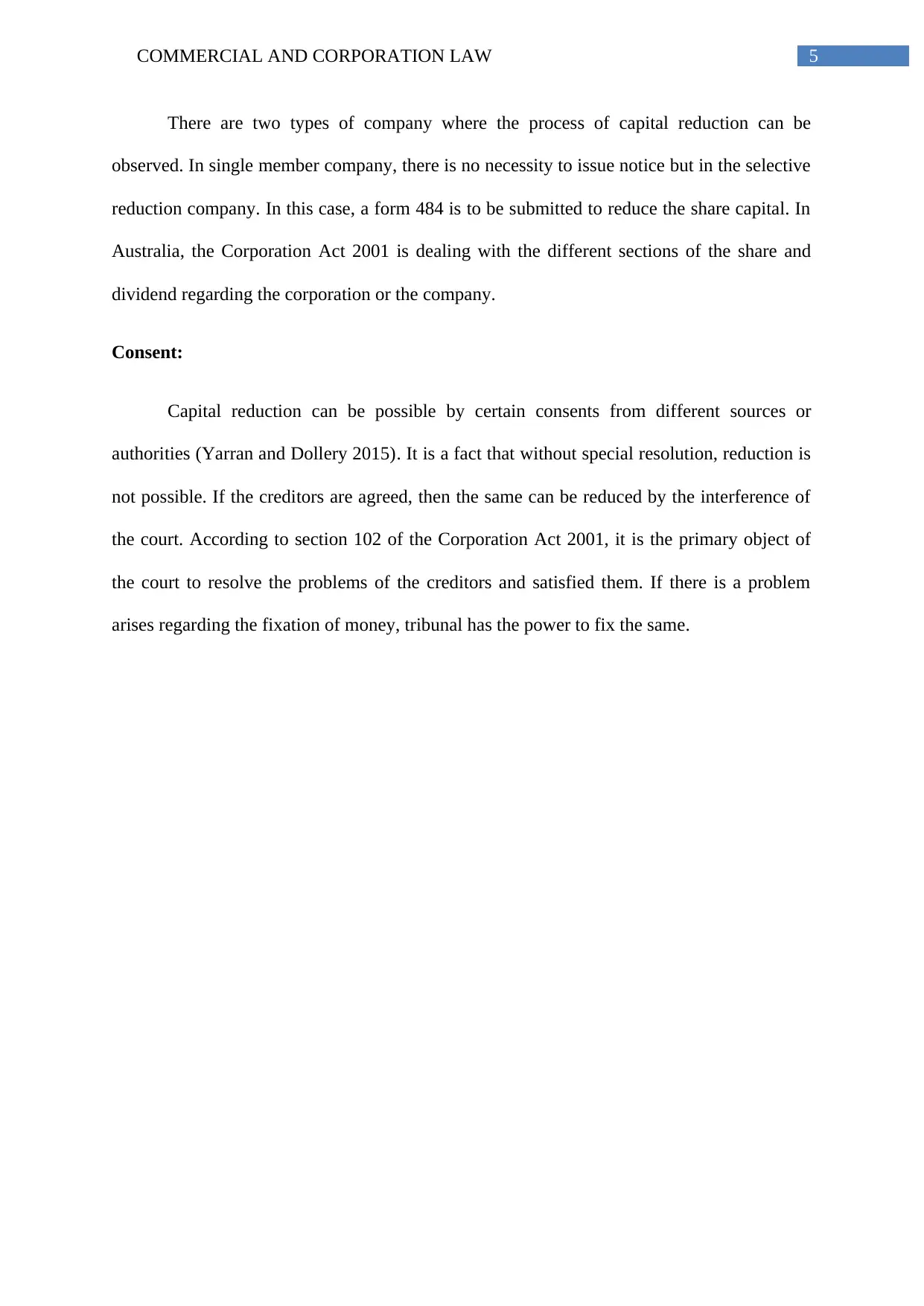
5COMMERCIAL AND CORPORATION LAW
There are two types of company where the process of capital reduction can be
observed. In single member company, there is no necessity to issue notice but in the selective
reduction company. In this case, a form 484 is to be submitted to reduce the share capital. In
Australia, the Corporation Act 2001 is dealing with the different sections of the share and
dividend regarding the corporation or the company.
Consent:
Capital reduction can be possible by certain consents from different sources or
authorities (Yarran and Dollery 2015). It is a fact that without special resolution, reduction is
not possible. If the creditors are agreed, then the same can be reduced by the interference of
the court. According to section 102 of the Corporation Act 2001, it is the primary object of
the court to resolve the problems of the creditors and satisfied them. If there is a problem
arises regarding the fixation of money, tribunal has the power to fix the same.
There are two types of company where the process of capital reduction can be
observed. In single member company, there is no necessity to issue notice but in the selective
reduction company. In this case, a form 484 is to be submitted to reduce the share capital. In
Australia, the Corporation Act 2001 is dealing with the different sections of the share and
dividend regarding the corporation or the company.
Consent:
Capital reduction can be possible by certain consents from different sources or
authorities (Yarran and Dollery 2015). It is a fact that without special resolution, reduction is
not possible. If the creditors are agreed, then the same can be reduced by the interference of
the court. According to section 102 of the Corporation Act 2001, it is the primary object of
the court to resolve the problems of the creditors and satisfied them. If there is a problem
arises regarding the fixation of money, tribunal has the power to fix the same.
⊘ This is a preview!⊘
Do you want full access?
Subscribe today to unlock all pages.

Trusted by 1+ million students worldwide
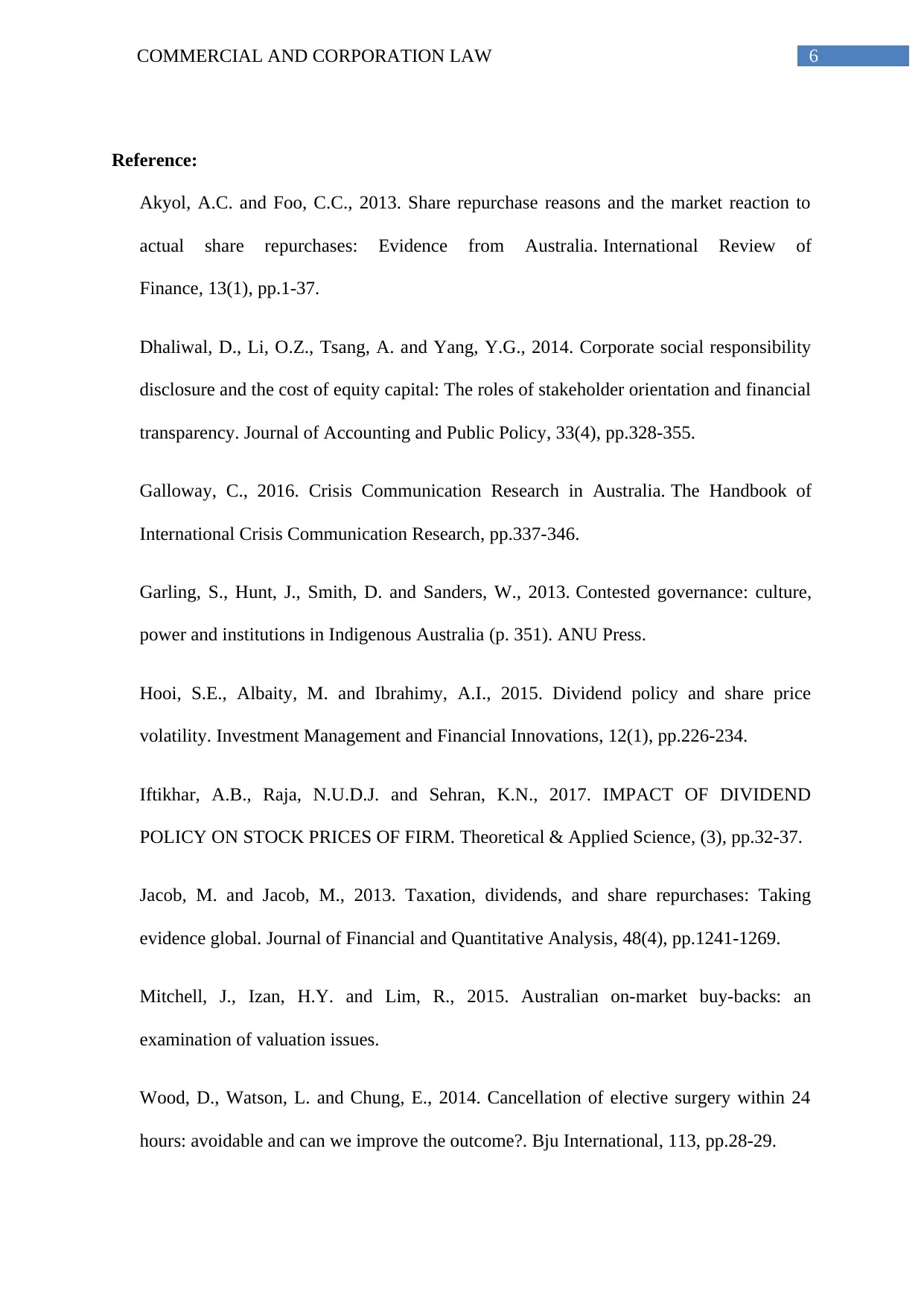
6COMMERCIAL AND CORPORATION LAW
Reference:
Akyol, A.C. and Foo, C.C., 2013. Share repurchase reasons and the market reaction to
actual share repurchases: Evidence from Australia. International Review of
Finance, 13(1), pp.1-37.
Dhaliwal, D., Li, O.Z., Tsang, A. and Yang, Y.G., 2014. Corporate social responsibility
disclosure and the cost of equity capital: The roles of stakeholder orientation and financial
transparency. Journal of Accounting and Public Policy, 33(4), pp.328-355.
Galloway, C., 2016. Crisis Communication Research in Australia. The Handbook of
International Crisis Communication Research, pp.337-346.
Garling, S., Hunt, J., Smith, D. and Sanders, W., 2013. Contested governance: culture,
power and institutions in Indigenous Australia (p. 351). ANU Press.
Hooi, S.E., Albaity, M. and Ibrahimy, A.I., 2015. Dividend policy and share price
volatility. Investment Management and Financial Innovations, 12(1), pp.226-234.
Iftikhar, A.B., Raja, N.U.D.J. and Sehran, K.N., 2017. IMPACT OF DIVIDEND
POLICY ON STOCK PRICES OF FIRM. Theoretical & Applied Science, (3), pp.32-37.
Jacob, M. and Jacob, M., 2013. Taxation, dividends, and share repurchases: Taking
evidence global. Journal of Financial and Quantitative Analysis, 48(4), pp.1241-1269.
Mitchell, J., Izan, H.Y. and Lim, R., 2015. Australian on-market buy-backs: an
examination of valuation issues.
Wood, D., Watson, L. and Chung, E., 2014. Cancellation of elective surgery within 24
hours: avoidable and can we improve the outcome?. Bju International, 113, pp.28-29.
Reference:
Akyol, A.C. and Foo, C.C., 2013. Share repurchase reasons and the market reaction to
actual share repurchases: Evidence from Australia. International Review of
Finance, 13(1), pp.1-37.
Dhaliwal, D., Li, O.Z., Tsang, A. and Yang, Y.G., 2014. Corporate social responsibility
disclosure and the cost of equity capital: The roles of stakeholder orientation and financial
transparency. Journal of Accounting and Public Policy, 33(4), pp.328-355.
Galloway, C., 2016. Crisis Communication Research in Australia. The Handbook of
International Crisis Communication Research, pp.337-346.
Garling, S., Hunt, J., Smith, D. and Sanders, W., 2013. Contested governance: culture,
power and institutions in Indigenous Australia (p. 351). ANU Press.
Hooi, S.E., Albaity, M. and Ibrahimy, A.I., 2015. Dividend policy and share price
volatility. Investment Management and Financial Innovations, 12(1), pp.226-234.
Iftikhar, A.B., Raja, N.U.D.J. and Sehran, K.N., 2017. IMPACT OF DIVIDEND
POLICY ON STOCK PRICES OF FIRM. Theoretical & Applied Science, (3), pp.32-37.
Jacob, M. and Jacob, M., 2013. Taxation, dividends, and share repurchases: Taking
evidence global. Journal of Financial and Quantitative Analysis, 48(4), pp.1241-1269.
Mitchell, J., Izan, H.Y. and Lim, R., 2015. Australian on-market buy-backs: an
examination of valuation issues.
Wood, D., Watson, L. and Chung, E., 2014. Cancellation of elective surgery within 24
hours: avoidable and can we improve the outcome?. Bju International, 113, pp.28-29.
Paraphrase This Document
Need a fresh take? Get an instant paraphrase of this document with our AI Paraphraser
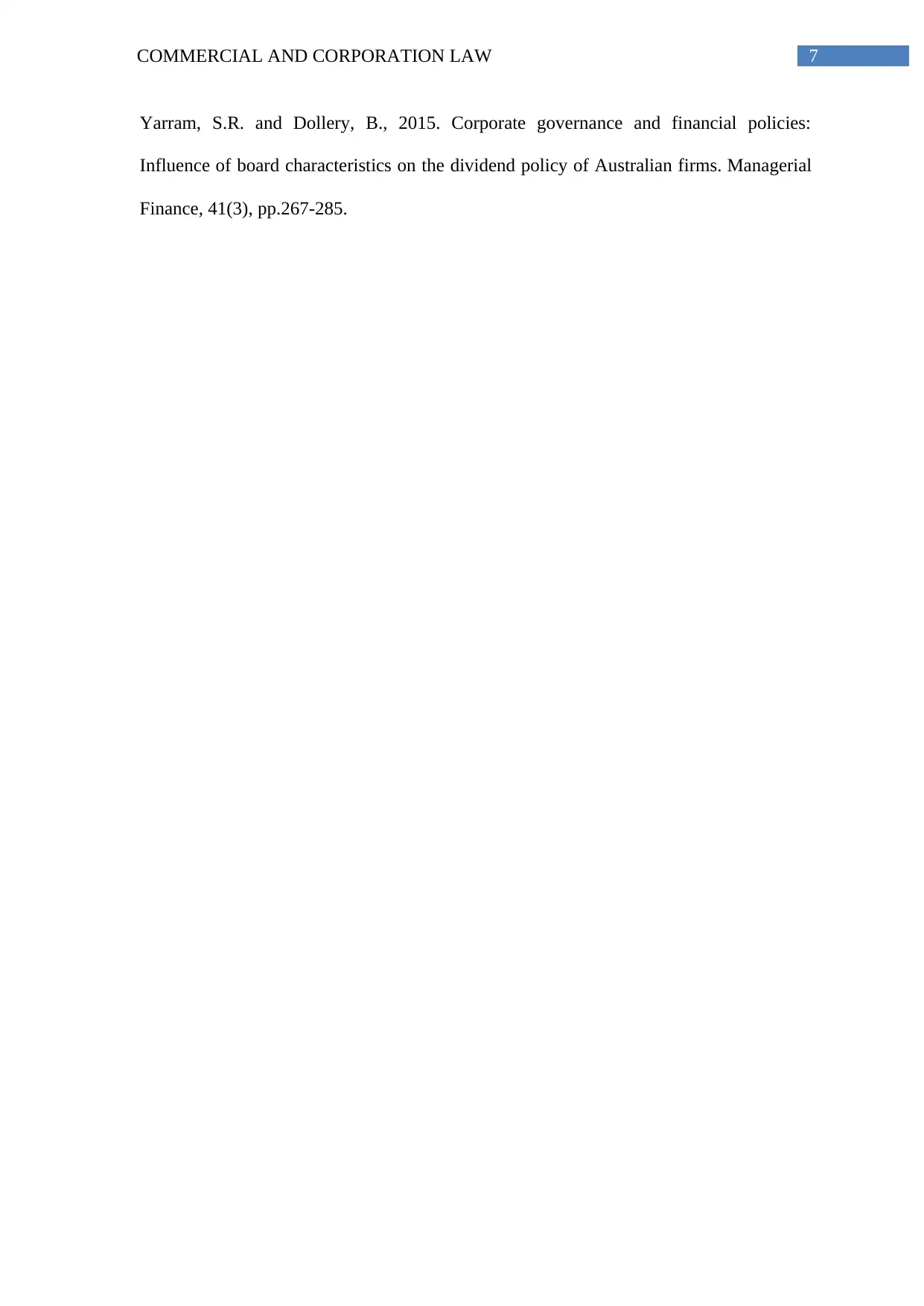
7COMMERCIAL AND CORPORATION LAW
Yarram, S.R. and Dollery, B., 2015. Corporate governance and financial policies:
Influence of board characteristics on the dividend policy of Australian firms. Managerial
Finance, 41(3), pp.267-285.
Yarram, S.R. and Dollery, B., 2015. Corporate governance and financial policies:
Influence of board characteristics on the dividend policy of Australian firms. Managerial
Finance, 41(3), pp.267-285.
1 out of 8
Related Documents
Your All-in-One AI-Powered Toolkit for Academic Success.
+13062052269
info@desklib.com
Available 24*7 on WhatsApp / Email
![[object Object]](/_next/static/media/star-bottom.7253800d.svg)
Unlock your academic potential
Copyright © 2020–2025 A2Z Services. All Rights Reserved. Developed and managed by ZUCOL.





